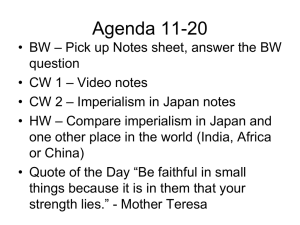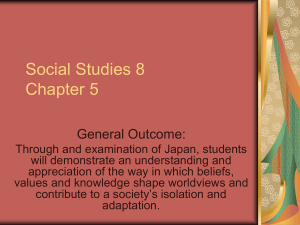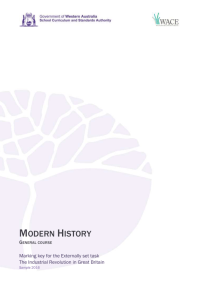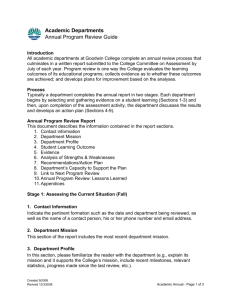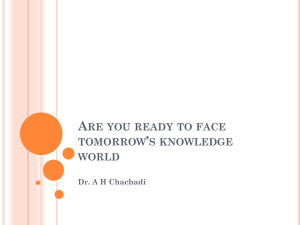Word Format
advertisement
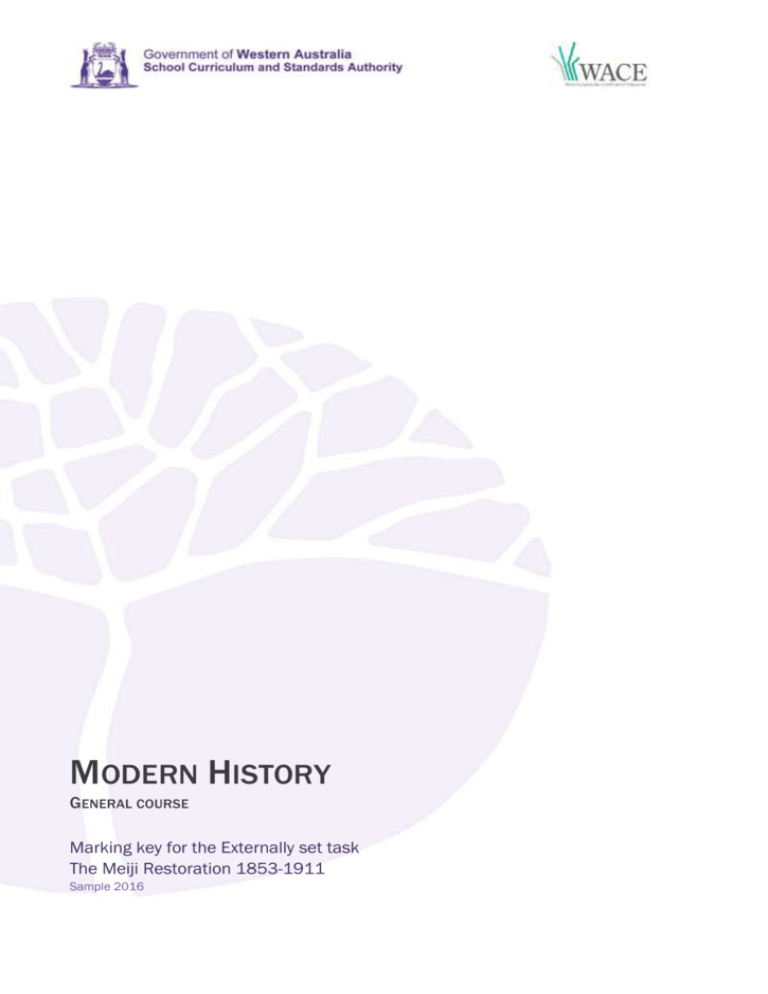
MODERN HISTORY GENERAL COURSE Marking key for the Externally set task The Meiji Restoration 1853-1911 Sample 2016 Copyright © School Curriculum and Standards Authority, 2014 This document – apart from any third party copyright material contained in it – may be freely copied, or communicated on an intranet, for non-commercial purposes in educational institutions, provided that the School Curriculum and Standards Authority is acknowledged as the copyright owner, and that the Authority’s moral rights are not infringed. Copying or communication for any other purpose can be done only within the terms of the Copyright Act 1968 or with prior written permission of the School Curriculum and Standards Authority. Copying or communication of any third party copyright material can be done only within the terms of the Copyright Act 1968 or with permission of the copyright owners. Any content in this document that has been derived from the Australian Curriculum may be used under the terms of the Creative Commons Attribution-NonCommercial 3.0 Australia licence Disclaimer Any resources such as texts, websites and so on that may be referred to in this document are provided as examples of resources that teachers can use to support their learning programs. Their inclusion does not imply that they are mandatory or that they are the only resources relevant to the course. 2014/9891 1 Modern History Externally set task – marking key NOTE – When marking a candidate’s work: 1. Not all points necessarily need to be in an answer for the candidate to gain full marks. 2. Reward each salient point made by the candidate. Candidates may make different valid points of interpretation. 3. Candidates are expected to refer to relevant supporting evidence from the sources. 1. Identify the historical context of Source 1. You may consider the following: the relevant event/s the significant person/people the key idea/s the change/s depicted in the source. Description Marks Uses supporting evidence and historical terminology to provide a clear identification of the historical context by EITHER: referring to all of the relevant factors listed above with some detail 4 included OR giving detailed information of at least two of the factors listed above. Uses minimal supporting evidence and historical terminology to identify some aspects of the historical context by EITHER: 2–3 listing at least two of the above factors (events, person, idea, change) OR giving detailed information of one of the factors listed above. Identifies a limited aspect of the historical context using no supporting evidence nor historical terminology. OR 1 Includes factually inaccurate information. OR Describes what is in the source without identifying the historical context. Total 4 Answer could include, but is not limited to: The context of Source 1 is the opening up of Japan for trade and Western ideas with the arrival of the Westerners, in particular Commodore Perry. Tokugawa Japan had remained a feudal society while Europe had experienced the Industrial Revolution and political change. Japan had deliberately remained isolated from the rest of the world. The USA demanded the opening of Japan to foreign ships due to the need for a coal supply en route to the Dutch East Indies. Modern History | General | Externally set task | Marking key | The Meiji Restoration 1853-1911 | Sample 2016 2 2. Compare and contrast the message/s of Source 1 with the message/s of Source 2. You should: identify the message/s of both sources show point/s of similarity show point/s of difference. Description Marks Uses supporting evidence and historical terminology to: accurately identify the key message/s in both Source 1 and Source 2 5–6 identify points of similarity in the message/s identify points of difference in the message/s. Uses minimal supporting evidence and historical terminology to: identify the message of both sources with some inaccuracies identify a key point of comparison 3–4 identify a key point of contrast. OR Accurately address the messages in detail, making minimal comparisons and/or contrasts between the two sources. Partially identifies the message/s with limited supporting evidence. OR 1–2 Discusses either comparisons OR contrasts without considering the messages. Total 6 Answer could include, but is not limited to: Source 1 key messages: This is a fearful message. Japan is under threat, perhaps even war, from the arrival of the “Black Ships”. The Shogun seems to be powerless. Source 2 key message: Commodore Perry is negotiating with Japanese officials in a respectful manner. These officials appear to be welcoming Perry. Perry is depicted as taller than the Japanese, perhaps suggesting that he has more power, even though the encounter seems civilised. Similarities: Both sources are concerned with the arrival of Commodore Perry and the “Black Ships” They are both from 1853 and both are from the Japanese point of view. Differences: Source 1 is fearful of what will happen, that there could be war and that the Shogun doesn’t appear organised. Source 2 suggests that the fears in Source 1 are unfounded and that Commodore Perry is treating the Japanese respectfully. Source 2 also mentions trade with Japan as being the reason for Perry coming to Japan. In Source 1, the “Black Ships” appear to have not come into port while, in Source 2, Perry has come ashore. Modern History | General | Externally set task | Marking key | The Meiji Restoration 1853-1911 | Sample 2016 3 3. Comment on the usefulness, in terms of strengths and weaknesses, of Source 3 as historical evidence. Depending on the source, you may consider the following: the type of source who produced the source when the source was produced the purpose of the source. Description Makes an informed general statement on the usefulness of the source as historical evidence. Comments on the strengths and weaknesses of Source 3 and includes an assessment of: strengths of at least two of the above considerations weaknesses of at least two of the above considerations. Makes a simple statement on the usefulness of the source as historical evidence. Shows some understanding of the strengths and weaknesses of Source 3, but: refers to the strength of one of the above considerations only refers to the weakness of one of the above considerations only. OR Refers to strengths only OR weaknesses only. Makes minimal reference to a strength or weakness of Source 3. OR Simply describes Source 3 with no reference to the particular strengths or weaknesses. Total Answer could include, but is not limited to: Strengths Created at the time – 1870. It depicts some of the impact of westernisation on Japanese society changes in transport changes in dress of some people. The source is a traditional woodblock and depicts the Japanese point of view. Weaknesses It is an idealised view of the westernisation of Japan. It does not show that there were problems with, and opposition to, the changes. It is a creative piece of work and may not show a real situation. Marks 4–5 2–3 1 5 Modern History | General | Externally set task | Marking key | The Meiji Restoration 1853-1911 | Sample 2016 4 4. Identify the perspective in Source 4 and give reasons for the perspective. Depending on the source, you may consider: the purpose of the source where it was produced when it was produced who produced the source. Description Marks Uses evidence to accurately identify the perspective of Source 4. Identifies the reasons for the perspective, which may include a brief discussion of: purpose of the source the significance of the where it was produced 4–5 the significance of when it was produced by whom it was produced. OR Accurately identifies the reasons for the perspective with a detailed discussion of at least two of factors listed above. Uses some evidence to comment on the perspective, however with some inaccuracy. 2–3 Identifies one or two of the reasons for the perspective, making generalised comments on significance. Attempts to identify the perspective with limited accuracy and no supporting evidence. OR 1 Limited identification of some of the reasons for the perspective with inaccuracies/misunderstandings present in the response. Total 5 Answer could include, but is not limited to: The perspective is that of a Westerner living and working in Japan at the time of the opening up of Japan to Western ideas, particularly industrialisation. He would have been aware of the changes occurring. The author is positively biased towards the Japanese for accepting Western technology and ideas, and for accepting the changes this has caused to the structure of society. The author expresses amazement at what has been achieved (‘Already the cotton mills threaten formidable rivalry to Lancashire’, Not a month passes…). He wants to make the world aware of what Japan has achieved. Modern History | General | Externally set task | Marking key | The Meiji Restoration 1853-1911 | Sample 2016 5 5. Using the four sources as a starting point, discuss change in the society you have studied. You should consider: the changes shown in the four sources other changes that have occurred in the society during the period of study the importance of the changes that you have identified. Description Marks Introduction 1 Includes a statement that identifies the changes to be covered OR 1 an outline of the narrative. The changes in society 5 Demonstrates an understanding of the changes which have occurred in the society, and their importance, by showing: 4–5 the relationship between events, people and ideas AND continuity and change. Provides a chronological narrative with some content about: 2–3 events and/or people and/or ideas AND change. Provides a simple, sometimes inaccurate, narrative with minimal reference to: 1 events, people, ideas OR change. Evidence used to support the discussion 4 Uses accurate evidence and, where appropriate, cites the evidence in some coherent fashion to illustrate: 3–4 the relationship between events, people and ideas AND continuity and change. Uses evidence to support the narrative, some of which is accurate, but contains some generalisations, to show: 2 events and/or people and/or ideas AND change. Limited evidence is used to support the discussion. 1 Total 10 Context specific points This question invites the student to write what they know about change during the whole period of study. The specific points made in the responses will depend on what has been taught in this unit. Responses should consider the particular changes that are shown in the sources (at least two per context are included). The responses should then consider the other major changes that have occurred in the society they are studying. These changes may be political, economic, social/cultural, international relations and/or leadership. The response then needs to consider the importance of the changes. Modern History | General | Externally set task | Marking key | The Meiji Restoration 1853-1911 | Sample 2016
